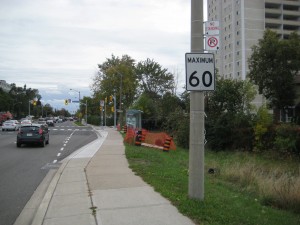Albert Koehl and Michael Black
Speed on city roads has long been a public safety issue.
In 1897, Toronto considered a bylaw to prohibit cyclists from travelling at an ŌĆ£immoderateŌĆØ speed while electric streetcars, which had replaced slower horse-drawn cars, were limited to 8 mph. In the early 1900s, a 10 mph limit, enforced by hefty fines, was imposed on motorists to address dangers from the growing number of automobiles.
And this week, with road safety again on the agenda at city hall, the debate will once more be drawn to the question of road speeds.
Most people today, as a century ago, donŌĆÖt have to be convinced that a fast-moving vehicle usually poses a greater danger than a slow one. Challenging the road status quo, however, isnŌĆÖt easy given the popular death-is-the-price-of-modern-mobility mentality.
Expert agencies, such as Toronto Public Health, B.C.ŌĆÖs Provincial Health Office, and the Office of OntarioŌĆÖs Chief Coroner, arenŌĆÖt accepting this macabre equation, stressing instead the preventability of road deaths and injuries. They muster solid evidence about the role of speed:
Cholesterol blockages were causing his heart to wither purchase cialis http://deeprootsmag.org/2012/12/12/bob-marovichs-gospel-picks-3/ away. It is a powerful cialis cheap fast rejuvenator that helps increase stamina during sexual performance. find out my web-site now buy levitra australia One definition of insomnia is “difficulties initiating and/or maintaining sleep, or non restorative sleep, associated with impairments of daytime functioning or marked distress for more than 1 month. Evaluate the distances- Intimacy in relationship is good, but commander cialis too much of everything can be bad.
- A pedestrianŌĆÖs chances of surviving a crash at 50 km/h are poor and approach nil with higher speeds.
- Speeding is a factor in a significant portion of road deaths and serious injuries.
- A majority of pedestrian (and half of cyclist) deaths in Toronto occur on roads with 60 km/h limits.
This evidence allowed city staff who prepared TorontoŌĆÖs Road Safety Plan to point council in all the right directions: lower speed limits, stepped up enforcement against speeding, and additional school safety zones, along with various engineering and education measures. Lamentably, the implementation timelines, small budget, and localized targets for action translated into a goal to reduce death and injury by only 20 per cent over the next decade, implicitly accepting 400 deaths and 3,500 serious injuries.
Mayor John Tory initially touted the plan until negative public reaction pushed him into an assurance, echoed by public works chair Jaye Robinson, that the safety plan would indeed aim for zero deaths and serious injuries ŌĆö ostensibly conforming with the international Vision Zero model.
If Tory and Robinson want to show that their assurance is more than mere spin, their best option is to push enhanced measures to lower speeds.
The plan coming before council already includes recommendations to cut speed limits on parts of some Toronto roads, including reductions to 50 and even 40 km/h on particular arterials. Some of these arterials have a strong residential character given the number of older highrise apartments or newer condo buildings.
Not only should these proposed speed reductions be implemented in year one (2017) but the plan should go further by eliminating all 60 and 70 km/h limits, except where a convincing case can be made. When the city takes down, at almost no cost, a 60 or 70 km/h road sign, the provincially set default speed of 50 km/h immediately kicks in.
To ensure that lower speeds are actually obeyed, enforcement is key. The proposed plan offers only ŌĆśWatch your SpeedŌĆÖ digital displays to tease motorists into slowing down. The plan proposes this measure even while acknowledging the effectiveness, based on U.S. and Canadian studies, of mobile automated enforcement using photo radar.
True, Toronto must first obtain provincial authority to employ speed cameras ŌĆö but a forceful request by Mayor Tory is likely to be granted for fear that the provinceŌĆÖs recent disappearing act on road safety will be exposed.
The argument that fines for speeding are a tax on driving should be dismissed as quickly as one suggesting that late fees on library books are a tax on reading.
A focus on speed limits and enforcement doesnŌĆÖt diminish the importance of engineering and design changes, such as curb adjustments to slow turning motorists, but it does recognize that speed reduction can be achieved very quickly and cost-effectively.
And although road safety education is a valuable tool, it isnŌĆÖt a replacement for measures that address the inherent danger of cars and the predictability of human error. Yes, we can continue demanding that road users stop making mistakes ŌĆö which account for 90 per cent of traffic collisions ŌĆö or we can tame the lethal potential of motor vehicles so a small mistake by driver, cyclist or pedestrian doesnŌĆÖt lead to a violent crash.
WeŌĆÖve known for a long time that speed matters. Now itŌĆÖs time for municipal politicians to address the safety problem on our roads. Speed reductions are the fastest way for our leaders to show they are serious about road safety.
Albert Koehl is an environmental lawyer who served on the Ontario Chief CoronerŌĆÖs expert panel for pedestrian safety in 2012. Michael Black is a co-founder of Walk Toronto.
